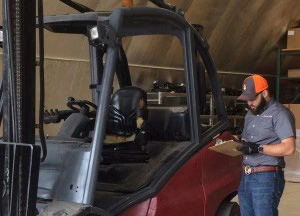
Powered industrial trucks, more commonly known as forklifts or lift trucks, are used to move materials in a variety of settings. From the warehouse to the shipyards, it isn’t unusual to see these familiar machines loading and unloading crates or material stacked on pallets. However, as with all heavy machinery, they are not without their hazards. Today, we’ll explore some of the top causes of forklift accidents and some ways you can work more safely on your worksite.
Forklift Training
Anyone wishing to operate a forklift must be properly trained. Employers are responsible for providing a combination of formal classroom instruction (lecture, video, etc.) and a practical evaluation where the operator demonstrates their knowledge of safe operations. Operators should receive refresher trainings at least every three years. Operators should be reevaluated if any of the following are true:
- If they had an accident or a near-miss
- They are observed operating unsafely
- If they received an evaluation stating they are operating unsafely
- They have been assigned to a different truck
- If worksite conditions change (Source: OSHA)
Speeding
When operating a forklift, travel slowly so as to maintain control of your forklift at all times and only operate at speeds that will permit the forklift to be stopped in a safe manner. Start, turn, and brake smoothly. Being in a hurry can cause a forklift to become unstable and result in an accident.
Elevated Loads
When operating a forklift you need to maintain a clear view of travel at all times. When traveling with a load, keep it as close to the ground as possible. If your forward vision is blocked, even partially, due to the load size or position, then travel in reverse or use a spotter.
Improper Turning
When a forklift is moving forward and abruptly turns to the right, the mass of the forklift still wants to go forward. Turning the wheels only makes the forklift turn sideways, and if the forklift is going too fast, then its momentum could cause it to tip over.
When turning, stay close to the inside corner and watch rear end swing. With or without a load, a fast turn can easily upset the machine and cause a forklift accident.
Warnings & Markings
Your horn is one of the most important safety tools on a forklift. Use it often to alert pedestrians of your presence. Post warning signs at intersections and on corners. Without barricades or warning signs in place, a pedestrian could walk under a raised load, which is an accident waiting to happen.
We offer forklift training. If you or any of your employees require training or refresher training, we are happy to help! Visit our website at www.hardhattraining.com.
Good luck and stay safe!
